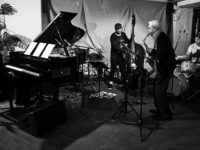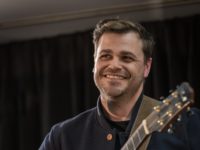feature photo: Deborah Randall Fisher, March 1975
The Miller brothers are talented multi-instrumentalists from Michigan whose interests in music stretched from the Stooges and the Mothers of Invention to Stockhausen and Eric Dolphy. Always thirsty to learn more and dig deeper, Roger, Benjamin and Laurence Miller had formed bands in the late 60’s-early 70s and later enrolled in the tiny Thomas Jefferson College art school. That’s when they decided to form a new group, one that synthesized all their diverse influences and do so without any restrictions on how to do it.
A fourth member Jack Waterstone (alto sax), who was also taking coursework at Thomas Jefferson, became the final piece of this puzzle. Though short-lived, the Fourth World Quartet still managed to put together a whole album’s worth of originals and a few interpretations that were recorded in March, 1975 but not seeing the light of day until the summer of 2021.
1975 is the plain title of these recordings but it doesn’t sound like most music of 1975 because it doesn’t really sound tied to any era. For one thing, the architecture of this band is decidedly atypical: Roger plays piano, Benjamin plays a brash, post-psychedelic electric guitar and also plays alto sax as he joins other the reed players Waterstone and Laurence Miller on bass clarinet.
The artful mixture of rock, classical and jazz has a lot similarities to what Henry Cow and Gong were doing at that time, even though those Canterbury groups had actual rhythm sections. Indeed, this might be about the closest an American band had gotten to sounding like the Canterbury scene at the time when this scene was thriving.
The obliteration of boundaries extend to the lines drawn between the charted and the improvised. “Pompeii” veers between a plodding, formal structure to a tornado of chaos at the slightest of cues. “Winter’s Dream” (which later became “Triassic, Jurassic, Cretaceous” on Birdsongs of the Mesozoic’s debut album) is constructed on a quick piano ostinato upon which all kinds of cacophony are whipped up on the fly and just dissolves into the ether.
It’s rather fun to hear Benjamin’s guitar collide with Roger’s piano — even uniting for part of the lines — during “The Transformation of Oz” as the horns come in and out of focus. That Roger-penned song was also re-used by him for his Birdsongs of the Mesozoic project of the 80s.
References to traditional jazz can be found everywhere even as they push the idiom to the frontier. “Glanmane” runs barely more than ninety seconds but its cheeky demeanor while heavily recalling 30s and 40s big band is a short burst of character. “Journey to Bubbleland” is much like a journey to Anthony Braxton-land, including some figures reaching back to early jazz amid the leading edge figures.
“Tnoona” is an Art Ensemble of Chicago song that Laurence had arranged and is devoid of improvisation but delves into subtle moods often found in modern classical music. Drums are actually played on “Ambrosia Triangle” — by Roger, as the piano is absent here — but the compelling thing about this performance is the tangled interplay among the reeds. At times it’s evocative of the coincidentally-named World Saxophone Quartet, which didn’t even exist yet.
Captured by Rick Scott on a 1/2 track Braun tape recorder, 1975 was probably never meant for release but there still aren’t any major quibbles with the recording (the remastering was probably a big help) and certainly no quibbles with the performances the Forth World Quartet gave. The band would go on to play only two shows and then call it a day. All four had continued to pursue music careers in endeavors of various types all the way to the present. It can be argued that for each of them, their careers have been outgrowths of the brief time when they got together and really went for it.
1975 is available now, from Cuneiform Records.




